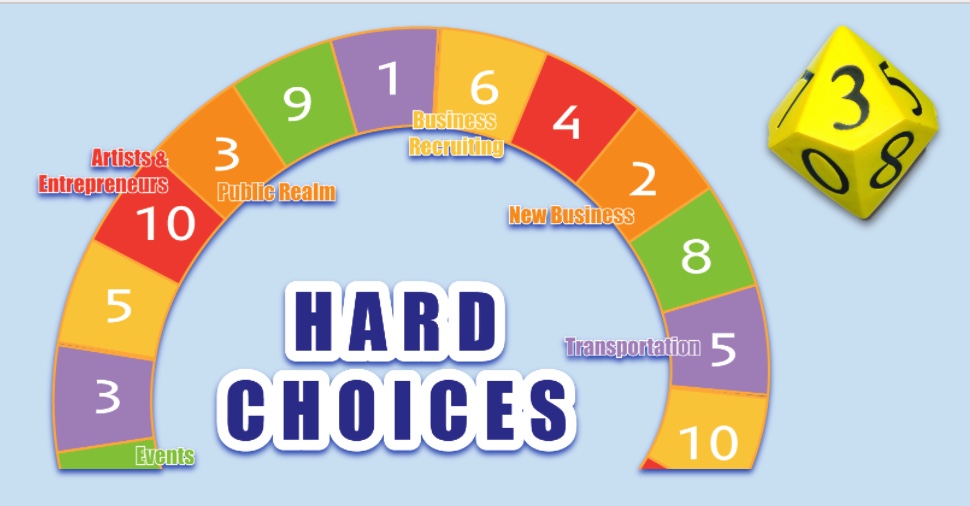
Selected designs, projects and collaborations are listed below.
1. Umbrella Initiatives (multi-year/complex)
Engaging Beyond Our Walls (EBOW) is a project to bring neighborhood games and stories to 59+ cities and towns through public libraries and museums. Funded by IMLS ($249k, 2021-2024) and featuring our new game engine, Hive Mechanic. Our goal is to increase the voice of residents in telling interactive stories, especially tied to local history and the public good.

Book in draft: Our Neighborhood Storytelling System launched with the Smithsonian and the DC Public Library in Washington, DC (2019-2021). The project installed listening stations at the front desk of libraries with more than 700,000 visitors over two years; it brought a repurposed payphone on wheels to the streets; and it mobilized a multimedia truck for traveling exhibits. As a model, he project offers a new approach to circulating stories of local history and activism tied to neighborhoods. Interactive projects remixed the content into scavenger hunts and raffles tied to local business. History is brought to the people, but the invitation is always for each of us to participate as well – to leave your story on a hotline, or speak with a curator on your own neighborhood streets. This project offers a new model for innovation at the community interface that is significantly different from typical museum strategies for outreach, technology, and even partnership. (Read more via these slides.)
2. Designs and Collaborations
The following designs were often made in collaboration with public libraries, community museums, and neighborhood residents.

A Sculpture that Talks Back / “Buoyant Oracle”
(Five year installation for the Tephra Arts Center).
To accompany this 50-foot surrealist sculpture, we designed an “oracle” to engage with visitors by text message. The oracle sends annotated photographs (similar to polaroids), revealing the hidden history and philosophy of the artwork. More playfully, the oracle picks different “readings” of paired poetry and remixed images of the sculpture for each visitor. Featuring mounted signs with QR codes that start the text message conversation.
Created in collaboration with artist Sue Wrbican; located in Reston, VA.

Scavenger Hunt: Murals and Activist Art
(Launched in 2020 — Washington, DC).
This mural hunt was co-designed for Adams Morgan Day (the longest-running neighborhood festival in DC). Using SMS clues and photographs, we led players to iconic murals and recent activist street art as part of #BLM protests. Supported social distancing during the pandemic.
Created in collaboration with the Adams Morgan Day 2020 Planning Committee.

Postcard Trivia Map on neighborhood history with the Smithsonian and DC Public Library
(2018-2019 –– Washington, DC).
For the longest-running neighborhood festival in DC, we created a trivia system that uses a paper map as the accessible interface. We’ve found that paper maps can be excellent starting points for an experience, coupled with historic photographs that are sent to visitors’ phones. For this event, we also reached large crowds by giving out the system phone number on stage between bands as part of a raffle for neighborhood gift certificates.

Crowdmapping DC Alleys
(2020 in Washington, DC).
We joined a group of architects to reimagine the 246 miles of DC alleys. Residents from across the city contacted our system by phone (no apps required), sending in photographs that were classified through conversation rather than forms. Meanwhile, in the gallery, photographs were automatically printed as they were sent in from the streets and displayed on the wall to provide an unfolding visualization of DC alleyways.
Created in collaboration with El Studio, the DC Alley Project, and the DC Architecture Center.

Hard Choices with the DC Office of Planning
(2021 for Penn Ave East in Washington, DC)
We created this outdoor game as a playful way to gather input on the future of a neighborhood. In the game, a charismatic “host” invites players to join at a sidewalk or public event. One player is selected to roll our ten-sided die. Their roll determines the “neighborhood futures” question that everyone will answer, displayed on a large screen or paper poster. Players can advocate for different futures, leave comments and discuss with their neighbors in person.

Storytelling Box and “Make-Your Own Exhibit” for the lobby of the DC Public Library
Designed to accompany an indoor mural, our physical storytelling box is an example of how to “make your own exhibit.” This storytelling box includes a listening headset, small screen for slides, and arcade buttons. Our RFID reader can recognize objects like laminated historical photos to show select content. Building your own storytelling box is ideal for makerspaces and STEM programs. The content can be controlled by Hive Mechanic, and the box itself uses a tiny computer called a Raspberry Pi that is popular among hobbyists.
(Always being updated — check back soon.)
